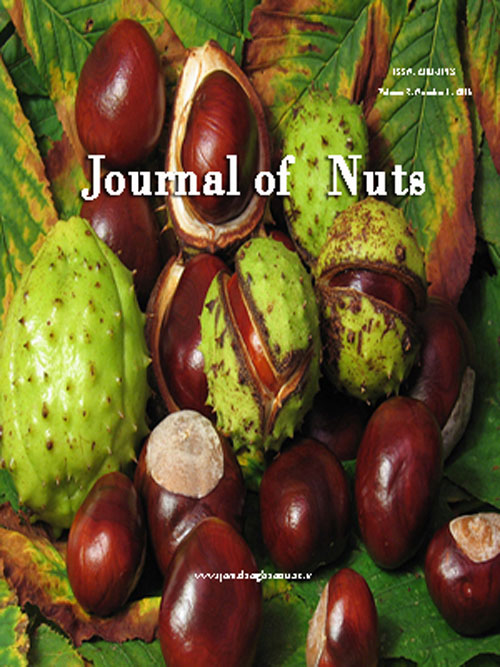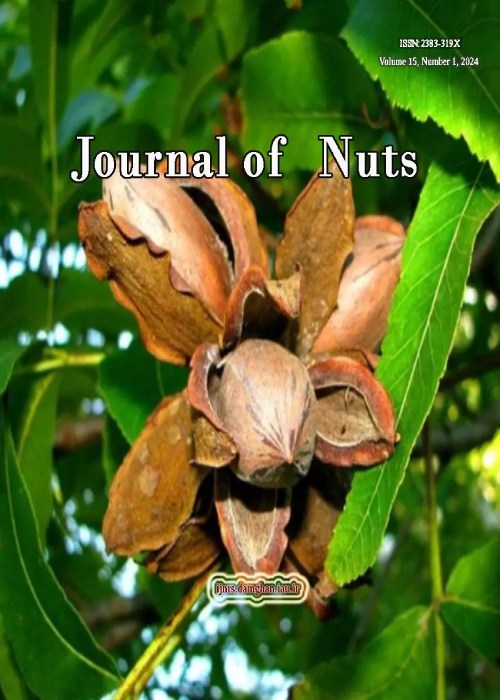فهرست مطالب

Journal of Nuts
Volume:8 Issue: 2, Summer-Autumn 2017
- تاریخ انتشار: 1396/10/17
- تعداد عناوین: 8
-
-
Pages 89-95Extraction of high quality RNA is a critical step in molecular genetics studies. Hazelnut is one of the most important nuts plants in the world. The presence of the taxol and other taxanes in hazelnut plant necessitates explaining their biosynthesis pathway and identifying the candidate genes. Therefore, an easy and practical method is necessary for RNA extraction from hazelnuts. Hazelnut has high levels of phenolic compounds. High amounts of polyphenolic and polysaccharide compounds in plants could be causing problems in RNA extraction procedures. To avoid these problems, a simple and efficient method can be used based on cetyltrimethylammonium bromide (CTAB) extraction buffer and lithium chloride for extraction of high quality RNA from different parts of hazelnut plant. Using this method, a high-quality RNA sample (light absorbed in the A260/A280 was 2.04Keywords: CTAB extraction, Hazelnut, RNA extraction, Taxol
-
Pages 97-106Grafting on epicotyl of young seedlings has been introduced as a simple and rapid method for walnut propagation. Although this technique improves the grafting success and propagation efficiency, it is technically more demanding than the conventional walnut grafting procedures and is yet to be optimized. This study was aimed to investigate the influence of rootstock type (dwarf and standard genotypes), graft union covering materials (perlite, sawdust, coco-peat and perlite at 1:1 ratio, and without cover - control) and different epicotyl grafting procedures (Gandev-Arnaudov and Frutos) on grafting success and performance of the grafted plants in order to optimize the walnut epicotyl grafting. Walnut seedlings were grown in a greenhouse. After four weeks, dormant shoots of walnut Chandler were grafted to the epicotyl of young walnut seedlings. Grafting success and callusing quality were recorded 30 days after grafting. Growth parameters of the grafted plants, including number of nodes and length of internodes, height and diameter of scion, and survival of the grafted plants, were determined 150 days after grafting. Enhanced grafting success and performance of the grafted scions were obtained by following the Frutoss procedure. Moreover, the highest grafting success (75.1%) and survival of the plants (91.7%) were obtained by using the dwarf rootstock and application of sawdust as graft union cover. In conclusion, performing walnut epicotyl grafting according to Frutoss procedure by using dwarf genotypes as rootstock and covering the graft union with sawdust was suggested to obtain maximum propagation efficiency (68.7%).Keywords: Callus, Covering materials, Epicotyl grafting, Growth, Juglans regia L, Vegetative propagation
-
Pages 107-114In this study, different methods for shell splitting and the effect of freezing prior to drying on shell splitting percentage of pistachio were investigated. A completely randomized design was used to investigate the effects of different freezing temperatures (0, -6, -12 and -18°C), different drying temperatures (80, 90 and 100°C) and different cultivars (Akbari and Kalehghouchi) on shell splitting percentages. The results showed that both freezing and drying temperature significantly (p ≤ 0.05) affected the splitting of closed shells into open shells. The effect of cultivar was insignificant. The highest shell splitting percentage (16.56%) was observed with a freezing temperature of -18°C and when a drying temperature of 100°C was used. Freezing and drying temperatures did not significantly increase the number of isolated kernels. However, in most treatments, isolated kernels were observed. Despite the isolated kernels, The shell splitting percentage did not decrease in any of the treatment groups. The results showed that freezing prior to drying can increase the percentage of split pistachio nuts. Thus, by increasing the difference between the temperature of the freezing and the temperature of drying, the percentage of split pistachio increased.Keywords: Closed shell, Cultivar, Pistachio, Shell splitting
-
Pages 115-122Ocneria terebinthina Strg. (Lep.: Lymanteriidae) is a leaf borer pest in pistachio orchard. The toxicity of Bacillus thuringiensis var. kurstaki alone and in combination with henna powder was investigated on third larval instar of O. terebinthina under laboratory conditions. Bioassay was carried out using spray technique on pistachio offshoot. Probit analysis of concentration-mortality data was conducted to estimate the LC50 value. The LC50 value of B. thuringiensis on third instar of larvae was estimated as 2817.30 ppm. The synergist effect of henna powder on efficacy of B. thuringiensis was also evaluated. Three concentrations of henna powder were combined with minimum lethal dose of B. thuringiensis against third larval instar. The results revealed that the henna powder had synergist effect on B. thuringiensis. The combination of B. thuringiensis and henna powder (6000 ppm) caused 80.68% mortality, whereas B. thuringiensis alone caused 15.91% mortality. Our results suggested that henna powder can increase the efficacy of B. thuringiensis in controlling O. terebinthina in pest integrated management.Keywords: Bacillus thuringiensis var. kurstaki, Lawsonia alba, LC50, Ocneria terebinthina, Synergist
-
Pages 123-135This study was conducted to evaluate the response of Iranian promisinglate blooming almond genotypes to deficit-irrigation stress on GN15 rootstock. One-year old plants subjectedto three deficit-irrigation, including moderate and severe stress (soil water potential, Ψsoil = -0.8 and -1.6 MPa, respectively) and a control treatment (Ψsoil= -0.33 MPa), were applied for six weeks to five grafting combinations. A factorial experiment was conducted with a CRD which included three irrigations factors, five genotype factors and three replications. Genotypes/cultivarsincluded: K3-3-1, H, 13-40, Sahand and Ferragness grafted on GN15 rootstock. Deficit-irrigation stress caused a significant reduction in plant growth parameters such as fresh and dry weights of plant organs, leafnumber, and total leafarea and leaf relativewatercontent in all almond genotypes and cultivars. Specific leaf weight (SLW) and leafabscission also significantly increased in drought-treated plants compared to the control group. Total shoot length, individual leaf area, leaf dimension (length and width), stomatal size and frequency were decreased in response to deficit-irrigation treatments. In response to stress, theFerragnes and Sahand cultivars on GN15 rootstock showed the highest relative water content (RWC) among the genotypes and showed the smallest decrease in fresh and dry weights of organs. The 13-40 and K3-3-1 genotypes showed the greatest leaf abscission and a decrease in the total leaf area, (the most reduction in transpiration area).Keywords: GN15, Growth Parameters, RWC, SLW
-
Pages 137-150The evaluation of an almond collection using morphological variables and identification of self-incompatibility genotype is useful for selecting pollinizers and for the design of crossing in almond breeding programs. In this study, important morphological traits and self-incompatibilities in 71 almond cultivars and genotypes were studied. Simple and multiplex specific PCR analyses were used in order to identify self-incompatibility alleles. Based on the results, cultivars and genotypes including Dir Rase-Savojbolagh, D-124, D-99, Shahrood 12, Tuono, Nonpareil, Price, Mirpanj-e-Tehran, Pakotahe-e- Taleghan, V-13-34, V-16-8, V-11-10, Zarghan 10, Uromiyeh 68, Barg dorosht-e-Hamedan and Yazd 60 were late flowering and had the highest quality of nut and kernel characters. The result of the PCR method using combined primers AS1II and AmyC5R showed amplification of ten self-incompatibility alleles (S1, S2, S3, S5, S6, S7, S8, S10, S12,and S unknown allele) and three Sfalleles. Moreover, S1 had the highest frequencies in comparison with other known S-alleles. Also, unknown alleles with different sizes were detected and 58 new bands were found in some cultivars.Keywords: AS1II, AmyC5R, Incompatibility, Kernel, Prunus dulcis, S-allele, Specific PCR
-
Pages 151-159The aim of this study is to evaluate the effects of water deficit stress on chlorophyll fluorescence (CF) characteristics of photosystem II (PSII) and pigment contents in two rootstock seedlings (Pistacia atlantica L. and P. khinjuk L.). Three levels of soil water potential (Ψs) was used, including WWD (-0.05 MPa), MWD (-0.7 MPa) and SWD (-1.5 MPa). It was found that water stress increased the minimal fluorescence (F0), quantum yield baseline (F0/Fm) and decreased the maximal fluorescence (Fm) and maximum quantum yield of PSII photochemistry (Fv/Fm) parameters in dark adapted leaves. In light adapted leaves, a significant increase in non-photochemical quenching (NPQ) and thermal dissipation of light energy to heat (D) and a decrease in electron transport rate (ETR) and photochemical efficiency of photosystem II (ΦPSII) occurred. The results demonstrated a decline in photosynthetic pigments (Chla), (Chlb) and carotenoids (Car) content with increasing water stress, whereas there was no significant effect on Chl (a/b) and Car/(a) ratios. Our data revealed there was no different in terms of performance between the two rootstocks in the alteration rate of pigment contents and photosynthetic features against soil water deficit conditions.Keywords: Minimal fluorescence electron transport, Photosystem, Pigments, Quantum yield, Water deficit
-
Pages 161-167The timing and lowering type of walnut genotypes (Juglans regia L.) is one of the important factors that lead to high and constant production. Therefore, the selection of homogame and spring frost tolerant genotypes has been among the most important priorities in breeding programs of walnut. The present paper analyzed the degree of dichogamy and the flowering time of 19 promising genotypes in walnuts from the sandy area, the S-V Oltenia region, Romania. Observations made over two calendar years have shown that the flowering period is influenced by environmental factors, especially temperature. The flowering time has changed from one year to the other, the high temperatures in spring accelerate the evolution of the male flowers,but the female flowers are not greatly influenced by these temperatures. Thus the type of flowering was not constantly, changing according to the climatic conditions of the two years. Knowing the type and timing of flowering of walnut genotypes is very important for pollination, because homogamy types are quite rare in the analyzed population.Keywords: Dichogamy, Flowering, Temperature, Walnut


